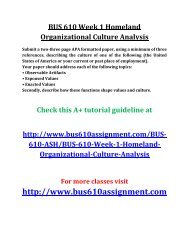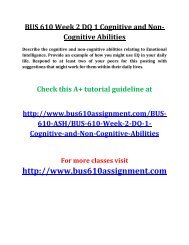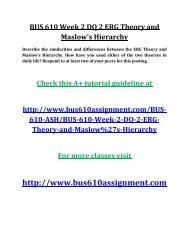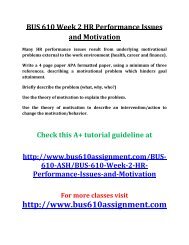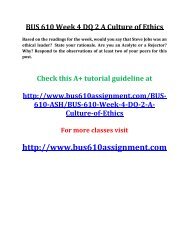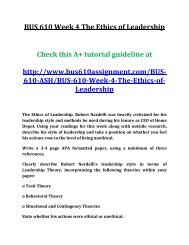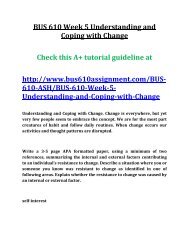DEVRY BSOP 434 Final Exam
bsop 434,devry bsop 434,devry bsop 434 entire course,devry bsop 434entire class,devry bsop 434 final exam,devry bsop 434 entire course includes final exams,devry bsop 434 week 1,devry bsop 434 week 2,devry bsop 434 week 3,devry bsop 434week 4,devry bsop 434 week 5,devry bsop 434 week 6,devry bsop 434 week 7,devry bsop 434 tutorials,devry bsop 434assignments,devry bsop 434 help
bsop 434,devry bsop 434,devry bsop 434 entire course,devry bsop 434entire class,devry bsop 434 final exam,devry bsop 434 entire course includes final exams,devry bsop 434 week 1,devry bsop 434 week 2,devry bsop 434 week 3,devry bsop 434week 4,devry bsop 434 week 5,devry bsop 434 week 6,devry bsop 434 week 7,devry bsop 434 tutorials,devry bsop 434assignments,devry bsop 434 help
You also want an ePaper? Increase the reach of your titles
YUMPU automatically turns print PDFs into web optimized ePapers that Google loves.
<strong>DEVRY</strong> <strong>BSOP</strong> <strong>434</strong> <strong>Final</strong> <strong>Exam</strong> - 2 Sets<br />
Check this A+ tutorial guideline at<br />
http://www.bsop<strong>434</strong>entirecourse.com/bs<br />
op-<strong>434</strong>-devry/bsop-<strong>434</strong>-final-exam<br />
For more classes visit<br />
http://www.bsop<strong>434</strong>entirecourse.com<br />
<strong>BSOP</strong> <strong>434</strong> <strong>Final</strong> <strong>Exam</strong> - 2 Sets<br />
Question 1. (TCO 10) ________ and ________ are the two basic organizational structures<br />
associated with logistics.<br />
Question 2. (TCO 10) One problem with a _________ logistics structure is that, because<br />
logistics activities are scattered throughout the firm, they likely remain subservient<br />
to the objectives of the department in which they are housed.<br />
Question 3. (TCO 3) Rate structures deal with three factors. Which of the following is<br />
not one of them?<br />
Question 4. (TCO 3) A transportation manager who purchases a pre specified level of<br />
transportation services, regardless of the mode and/or carrier providing the<br />
transportation services, is known as a(n):<br />
Question 5. (TCO 2) A function in organization that encompasses all activities<br />
associated with the flow and transformation of goods from the raw material stage<br />
through to the end user, as well as the associated information flows, is termed:
Question 6. (TCO 2) Which of the following is not a key attribute of supply-chain<br />
management?<br />
Question 7. (TCO 1) Inventory held for a number of reasons, including projected<br />
price increases, seasonal demand, and potential stockouts, is referred to as:<br />
Question 8. (TCO 1) Vendor managed inventory (VMI) benefits include:<br />
Question 9. (TCO 8) International freight forwarders can provide a number of<br />
functions. Which is not one of them?<br />
Question 10. (TCO 8) What is used in areas where dock workers cannot read but<br />
need a method to keep documents and shipments together?<br />
Question 11. (TCO 7) Which of the following statements is false?<br />
Question 12. (TCO 7) The raw materials, component parts, and supplies bought from<br />
outside organizations to support a company’s operations define:<br />
Question 13. (TCO 4) Logisticians and supply chain managers have a particular<br />
interest in ____ taxes.<br />
Question 1. (TCO 4) A brownfield is:<br />
Question 2. (TCO 5) ____ regulates the packaging of international air shipments.<br />
Question 3. (TCO 5) ____ systems consider the reverse flow of products, their reuse,<br />
and the marketing and distribution of recovered products.<br />
Question 4. (TCO 6) The order cycle is:<br />
Question 5. (TCO 6) Order transmittal is:<br />
Question 6. (TCO 9) How do data and information differ?<br />
Question 7. (TCO 9) Which of the following is not considered a general software<br />
package?<br />
Question 8. (TCO 12) Surveys and analog techniques are examples of ____ forecasting.<br />
Question 9. (TCO 12) Which forecasting techniques tend to be appropriate when<br />
there is little or no historical data?<br />
Question 10. (TCO 11) A(n) ____ rate simplifies each of the three primary rate<br />
factors—product, weight, and distance.
Question 11. (TCO 11) The shipment size that equates transportation charges for<br />
different weights and weight groups is the ____ concept.<br />
Question 12. (TCO 13) Throughput refers to:<br />
Question 13. (TCO 13) ____ refers to a process where a product is received in a facility,<br />
occasionally married with a product going to the same destination, and is then<br />
shipped at the earliest time, without going into longer-term storage.<br />
Question 1. (TCO 4) What is a free trade zone?<br />
Question 2. (TCO 9) Discuss some of the challenges associated with computer<br />
security.<br />
Question 3. (TCO 9) Why are some companies hesitant to adopt RFID technology?<br />
Question 4. (TCO 12) Forecasting accuracy refers to the relationship between actual<br />
and forecasted demand, and accuracy can be affected by various considerations.<br />
What is one of the challenges with the analog technique?<br />
Question 5. (TCO 13) According to the text, what is contract warehousing?<br />
Question 6. (TCO 14) What areas and/or activities are typically planned to be<br />
included into Distribution Resource Planning (DRP)?<br />
Question 7. (TCO 3) How are carriers legally classified?<br />
Question 8. (TCO 6) What is order management?<br />
Question 9. (TCO 5) Compare and contrast the various handling characteristics<br />
associated with bulk cargoes.<br />
Question 10. (TCO 6) <strong>Exam</strong>ine the various methods of order transmittal and<br />
differentiate the relevant characteristics of each one.<br />
Question 11. (TCO 11) Compare and contrast the three primary factors for<br />
determining



